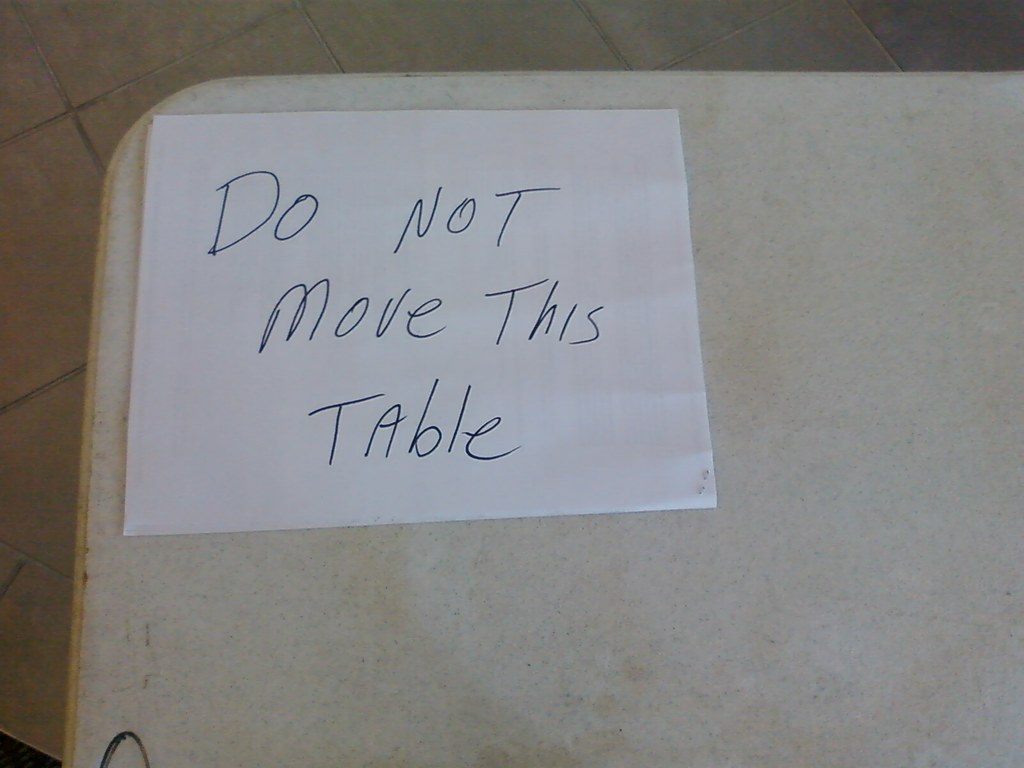Last weekend I was at devLink in Nashville. On Thursday I was trying to finish up some work and looked for a quiet spot, so I headed to the then-empty room where Open Spaces would be held the following two days. The room was a chapel at the venue’s campus; a great quiet spot where I could try to focus and get some things done. The room had lots of windows letting in beautiful natural light, and there was a wonderful high, vaulted ceiling with some nice decorative architecture. In short, a great place to get some undisturbed work done.
Up at the front of the chapel was a table with two signs taped on it:

Interesting. I wondered about the rationale behind the signs, but I was in a hurry to get some work done, so I sat down in a different corner and tried to finish up my tasks. In between productive sprints of work, my brain kept coming back to the signs. “Why?” I wondered.
Eventually, I began to think about how others might react to the sign. Being ever-interested in how my community hommies react to various things, I even went so far as to mention the sign to a few folks the next day.
“Hey, the table in the Open Spaces room has a sign that says to not move the table,” I mentioned.
One friend said “The sign says not to move it? I’M MOVING THE DAMN TABLE!”
Another pal said “If I need that space I’m moving the table.”
A third simply said “OK, so we won’t move it.”
All three reactions were somewhat interesting, because none of the three asked “Why’s the sign there?” My first friend, being somewhat wonderfully contrarian in nature, was going to move the table simply because he’d been told not to. The second was going to move the table if he needed the space. The third just agreed to deal with the limitation and move on.
Bear with me, because there’s actually a point here.
Flash back to Thursday and my quiet working time in the chapel. After an hour or so, two workmen came in to the chapel and went over to the area by the table. They were discussing some painting that had to happen, so I sort of tuned them out. My ears perked up, however, when I heard them mention a water leak which had caused significant damage to the structure. It turns out they’d had issues with parts of the extremely high ceiling falling down onto the floor.
The table was placed on that exact spot to block people from standing or sitting there. The “Do not move this table” sign was intended to ensure nobody was injured by falling debris.
One could sit around and argue that the sign was badly written, leaving out critical information (“Sit here and you will DIE!”), or that something else should have been used to block off that area. (Police tape, orange snow fence, flashing lights, Albanian dwarf mimes)
Those arguments are missing the point. The sign made perfect sense to those who wrote it and there was a darn good reason for the sign being there.
We constantly run in to similar situations with the folks we’re building software for. What seems an utter mystery to us is utterly clear to our clients, customers, stakeholders, whoever. Moreover, sometimes there’s something really important behind those things that seem, to us, stupid and incomprehensible. We’re outsiders, and we’re missing the critical context.
Spend the time asking “Why?” with those whose problems you’re trying to solve.
You may save yourself getting schwacked on the head with debris.


6 comments:
This is true not just of trying to understand customers, but also in trying to understand why previous developers wrote code in the fashion they did. Coders have this wonderful habit of instantly criticizing other people's code without understanding the context under which that code was written. Without that context, who are you to judge whether the code made sense at the time and in the context in which it was written.
Joe: You're absolutely right, and I meant to apply this in a broader fashion in my post. Thanks for bringing this up!
There's also the possibility that the sign was put there by the last person/org to use that room and it is no longer required.
The IT application to this is asking "why do you do it that way?" and the reply is, "I don't know, it's the way I was shown when I started and the same with the guy who trained me."
So I guess the real question is... Did the table get moved? Did anybody get bonked on the head? :)
I agree with Joe too, even when looking at old code with old (vague) comments, I realize that more information should have been given up front rather than chancing a lengthy revisit to the reason years later trying to figure out WHY I wrote that.
Nice post. :)
Interesting presentation on Signs. Also an interesting presentation style (Pecha Kucha) http://www.youtube.com/watch?v=9NZOt6BkhUg
Post a Comment